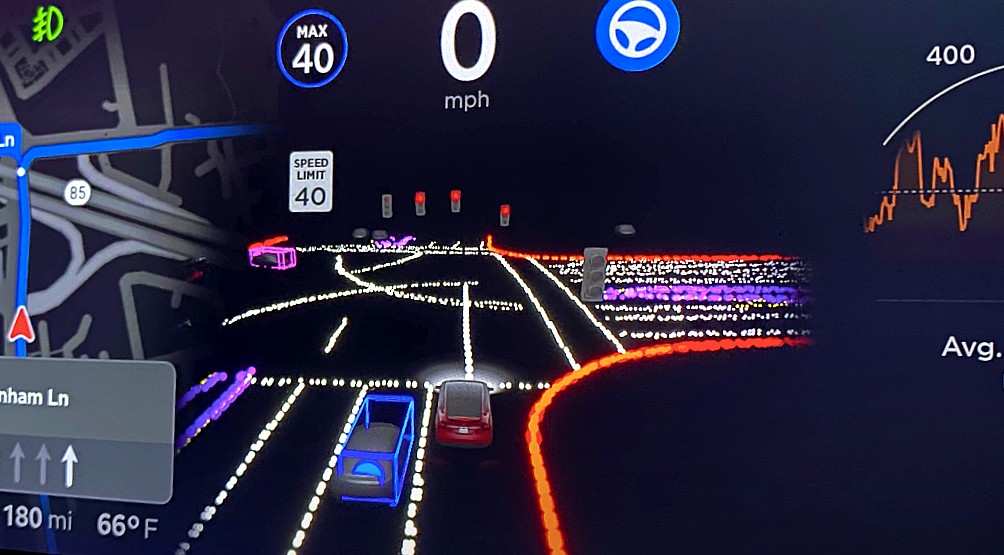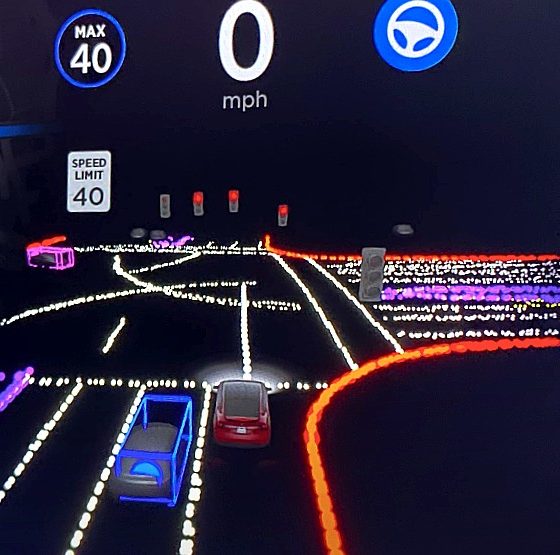Tesla owners @tesla_raj and @teslaownersSV recently went out on the open road to conduct a real-world test of the EV automaker’s limited Full Self-Driving beta update. FSD’s limited beta was released in late October 21 to early access Tesla owners, and it’s expected to represent some of the improvements resulting from the company’s Autopilot rewrite.
Speaking about the FSD update, Tesla Raj noted how distinctly different Tesla’s Full Self-Driving software acted as soon as it hit the road during his real-world test. “So when getting into the car, it didn’t initially get presented with Full Self-Driving, until you were out of your driveway but still in a residential court. It was at that moment that the screen changed into a computerized graphic from the future that basically looked like you were seeing what the computer sees,” he said in a YouTube video about his experience.
The new FSD visuals give the impression that drivers are seeing into the mind that Tesla’s AI team built. The electric car enthusiast noticed that the car seemed to be seeing much more than it used to, from the shoulder of the road before turning to people walking around the car, and more.
The two Tesla enthusiasts activated FSD while navigating through city streets, a function that Full Self-Driving’s previous iterations did not have the capability to do. He stated that Tesla’s FSD was heavily dependent on lane markers before the limited beta’s release. Its dependence on lane markers made it difficult for FSD to navigate residential streets.
The new update didn’t seem to have any trouble driving through a residential area, nor did it have trouble with turns. Previously, FSD did not make left and right turns on its own. Tesla’s Full Self-Driving software only kept the car in its lane, helped merge out of lanes, and stopped at red traffic lights or stop signs with confirmation.
During their real-world test, the two EV enthusiasts demonstrated how Teslas could perform turns with the limited FSD beta. The feat might be minor for most experienced drivers, but not so much for new ones. Making turns can be scary even for human drivers after all, especially in crowded roads with drivers that are lacking in the tact department. So FSD making a turn on its own, and carefully at that, is quite an accomplishment.
The duo was also able to see the difference between FSD’s reaction to a stoplight in an intersection and a green light in an intersection. Tesla Raj observed how human-like FSD acted in these instances. For example, the car stopped at intersections and crept forward slowly–as if it were pausing to check if there were oncoming cars–before executing the turn.
The tiny action really showcased how far Tesla has come in the development of FSD. In the past few months, Elon Musk provided Tesla owners with tidbits here and there about the improvements that will be coming with the Autopilot rewrite. He teased the profound ramifications of the rewrite, particularly in relation to FSD. And when Tesla finally released the limited FSD beta, it certainly did not disappoint.
Tesla’s limited FSD beta will continue to roll out to more early access owners during the weekend, giving the community something to look forward to as the workweek ends. As Full Self-Driving beta is released to more early access owners, Tesla CEO Elon Musk announced that the price of FSD would be raised by $2,000 soon. The current price of FSD is $8,000. Later, he tweeted the price increase would take effect on Thursday, October 29, for the US market only.
Watch Tesla Raj’s insights about his experiences with the limited FSD beta in the video below.

Investor's Corner
Tesla stock closes at all-time high on heels of Robotaxi progress

Tesla stock (NASDAQ: TSLA) closed at an all-time high on Tuesday, jumping over 3 percent during the day and finishing at $489.88.
The price beats the previous record close, which was $479.86.
Shares have had a crazy year, dipping more than 40 percent from the start of the year. The stock then started to recover once again around late April, when its price started to climb back up from the low $200 level.
This week, Tesla started to climb toward its highest levels ever, as it was revealed on Sunday that the company was testing driverless Robotaxis in Austin. The spike in value pushed the company’s valuation to $1.63 trillion.
Tesla Robotaxi goes driverless as Musk confirms Safety Monitor removal testing
It is the seventh-most valuable company on the market currently, trailing Nvidia, Apple, Alphabet (Google), Microsoft, Amazon, and Meta.
Shares closed up $14.57 today, up over 3 percent.
The stock has gone through a lot this year, as previously mentioned. Shares tumbled in Q1 due to CEO Elon Musk’s involvement with the Department of Government Efficiency (DOGE), which pulled his attention away from his companies and left a major overhang on their valuations.
However, things started to rebound halfway through the year, and as the government started to phase out the $7,500 tax credit, demand spiked as consumers tried to take advantage of it.
Q3 deliveries were the highest in company history, and Tesla responded to the loss of the tax credit with the launch of the Model 3 and Model Y Standard.
Additionally, analysts have announced high expectations this week for the company on Wall Street as Robotaxi continues to be the focus. With autonomy within Tesla’s sights, things are moving in the direction of Robotaxi being a major catalyst for growth on the Street in the coming year.
Elon Musk
Tesla needs to come through on this one Robotaxi metric, analyst says
“We think the key focus from here will be how fast Tesla can scale driverless operations (including if Tesla’s approach to software/hardware allows it to scale significantly faster than competitors, as the company has argued), and on profitability.”

Tesla needs to come through on this one Robotaxi metric, Mark Delaney of Goldman Sachs says.
Tesla is in the process of rolling out its Robotaxi platform to areas outside of Austin and the California Bay Area. It has plans to launch in five additional cities, including Houston, Dallas, Miami, Las Vegas, and Phoenix.
However, the company’s expansion is not what the focus needs to be, according to Delaney. It’s the speed of deployment.
The analyst said:
“We think the key focus from here will be how fast Tesla can scale driverless operations (including if Tesla’s approach to software/hardware allows it to scale significantly faster than competitors, as the company has argued), and on profitability.”
Profitability will come as the Robotaxi fleet expands. Making that money will be dependent on when Tesla can initiate rides in more areas, giving more customers access to the program.
There are some additional things that the company needs to make happen ahead of the major Robotaxi expansion, one of those things is launching driverless rides in Austin, the first city in which it launched the program.
This week, Tesla started testing driverless Robotaxi rides in Austin, as two different Model Y units were spotted with no occupants, a huge step in the company’s plans for the ride-sharing platform.
Tesla Robotaxi goes driverless as Musk confirms Safety Monitor removal testing
CEO Elon Musk has been hoping to remove Safety Monitors from Robotaxis in Austin for several months, first mentioning the plan to have them out by the end of 2025 in September. He confirmed on Sunday that Tesla had officially removed vehicle occupants and started testing truly unsupervised rides.
Although Safety Monitors in Austin have been sitting in the passenger’s seat, they have still had the ability to override things in case of an emergency. After all, the ultimate goal was safety and avoiding any accidents or injuries.
Goldman Sachs reiterated its ‘Neutral’ rating and its $400 price target. Delaney said, “Tesla is making progress with its autonomous technology,” and recent developments make it evident that this is true.
Investor's Corner
Tesla gets bold Robotaxi prediction from Wall Street firm
Last week, Andrew Percoco took over Tesla analysis for Morgan Stanley from Adam Jonas, who covered the stock for years. Percoco seems to be less optimistic and bullish on Tesla shares, while still being fair and balanced in his analysis.

Tesla (NASDAQ: TSLA) received a bold Robotaxi prediction from Morgan Stanley, which anticipates a dramatic increase in the size of the company’s autonomous ride-hailing suite in the coming years.
Last week, Andrew Percoco took over Tesla analysis for Morgan Stanley from Adam Jonas, who covered the stock for years. Percoco seems to be less optimistic and bullish on Tesla shares, while still being fair and balanced in his analysis.
Percoco dug into the Robotaxi fleet and its expansion in the coming years in his latest note, released on Tuesday. The firm expects Tesla to increase the Robotaxi fleet size to 1,000 vehicles in 2026. However, that’s small-scale compared to what they expect from Tesla in a decade.
Tesla expands Robotaxi app access once again, this time on a global scale
By 2035, Morgan Stanley believes there will be one million Robotaxis on the road across multiple cities, a major jump and a considerable fleet size. We assume this means the fleet of vehicles Tesla will operate internally, and not including passenger-owned vehicles that could be added through software updates.
He also listed three specific catalysts that investors should pay attention to, as these will represent the company being on track to achieve its Robotaxi dreams:
- Opening Robotaxi to the public without a Safety Monitor. Timing is unclear, but it appears that Tesla is getting closer by the day.
- Improvement in safety metrics without the Safety Monitor. Tesla’s ability to improve its safety metrics as it scales miles driven without the Safety Monitor is imperative as it looks to scale in new states and cities in 2026.
- Cybercab start of production, targeted for April 2026. Tesla’s Cybercab is a purpose-built vehicle (no steering wheel or pedals, only two seats) that is expected to be produced through its state-of-the-art unboxed manufacturing process, offering further cost reductions and thus accelerating adoption over time.
Robotaxi stands to be one of Tesla’s most significant revenue contributors, especially as the company plans to continue expanding its ride-hailing service across the world in the coming years.
Its current deployment strategy is controlled and conservative to avoid any drastic and potentially program-ruining incidents.
So far, the program, which is active in Austin and the California Bay Area, has been widely successful.










